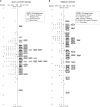Functioning of young patients with cerebral palsy: Rasch analysis of the pediatric evaluation of disability inventory computer adaptive test daily activity and mobility
- PMID: 33208162
- PMCID: PMC7672984
- DOI: 10.1186/s12955-020-01624-5
Functioning of young patients with cerebral palsy: Rasch analysis of the pediatric evaluation of disability inventory computer adaptive test daily activity and mobility
Abstract
Background: People with cerebral palsy experience limitations in performing activities of daily living. Rehabilitation practitioners seek valid instruments to measure changes in the performance of those activities. The Pediatric Evaluation of Disability Inventory Computer Adaptive Test (PEDI-CAT) is a new tool to assess functioning in children and youth with various health conditions. Its validity needs to be evaluated in a way that is consistent with the theoretical model on which it was based. We aimed to evaluate the fit of daily activity and mobility items and children with CP to the Rasch model and to compare the performance in daily activities and mobility of older children, adolescents, and young adults with CP based on manual function and gross motor function limitations.
Methods: Eighty-three parents of children and youth of 8-20 years old (mean age: 11.6) with different severity levels of cerebral palsy participated in this study. Ninety-one items of the PEDI-CAT Daily Activities and Mobility domains were analyzed through Rasch analysis to evaluate relative item difficulty and participant ability. Participants were described according to the Manual Ability (MACS) (level I: 21.7%; II: 32.5%; III: 24.1%; IV: 7.2% and V: 3.6%) and the Gross Motor Function (GMFCS) (level I: 37.3%; II: 26.5%; III: 6%; IV: 18.1%; and V: 7.2%) classification systems levels.
Results: Our data fit the Rasch Model. Parents had difficulty distinguishing some PEDI-CAT response categories. Participants from MACS and GMFCS levels IV and V showed lower ability to perform relatively more difficult items. There was a floor effect in both domains. Only 7.7% of the items presented differential item functioning when individuals with mild MACS and GMFCS levels (I, II) and moderate level (III) and individuals with moderate (III) and severe levels (IV, V) were compared.
Conclusions: PEDI-CAT daily activities and mobility domains are valid to evaluate children, adolescents and youth with CP of different severities, but the addition of items to these domains is recommended in order to address their floor effect.
Keywords: Activities of daily living; Cerebral palsy; Mobility limitation.
Conflict of interest statement
The authors declare that they have no competing interests.
Figures


Similar articles
-
Evaluating the Discriminant Validity of the Pediatric Evaluation of Disability Inventory: Computer Adaptive Test in Children With Cerebral Palsy.Phys Ther. 2017 Jun 1;97(6):669-676. doi: 10.1093/ptj/pzx033. Phys Ther. 2017. PMID: 28379484
-
Measuring the Reliability and Construct Validity of the Pediatric Evaluation of Disability Inventory-Computer Adaptive Test (PEDI-CAT) in Children With Cerebral Palsy.Arch Phys Med Rehabil. 2019 Jan;100(1):45-51. doi: 10.1016/j.apmr.2018.07.427. Epub 2018 Aug 18. Arch Phys Med Rehabil. 2019. PMID: 30130519
-
Development and Validation of Equations to Link Pediatric Evaluation of Disability Inventory (PEDI) Functional Skills Scores to PEDI-Computer Adaptive Test Scores for Youth with Cerebral Palsy.Phys Occup Ther Pediatr. 2020;40(1):106-120. doi: 10.1080/01942638.2019.1628160. Epub 2019 Jun 17. Phys Occup Ther Pediatr. 2020. PMID: 31203687
-
Socioeconomic Status Influences Functional Severity of Untreated Cerebral Palsy in Nepal: A Prospective Analysis and Systematic Review.Clin Orthop Relat Res. 2019 Jan;477(1):10-21. doi: 10.1097/CORR.0000000000000476. Clin Orthop Relat Res. 2019. PMID: 30179955 Free PMC article.
-
Measurement properties of the Gross Motor Function Classification System, Gross Motor Function Classification System-Expanded & Revised, Manual Ability Classification System, and Communication Function Classification System in cerebral palsy: a systematic review with meta-analysis.Dev Med Child Neurol. 2021 Nov;63(11):1251-1261. doi: 10.1111/dmcn.14910. Epub 2021 May 24. Dev Med Child Neurol. 2021. PMID: 34028793
Cited by
-
The Psychometric Properties of the Trunk Impairment Scale in Children with Cerebral Palsy.Children (Basel). 2022 Mar 19;9(3):435. doi: 10.3390/children9030435. Children (Basel). 2022. PMID: 35327807 Free PMC article.
-
Reliability and Acceptability to Caregivers of Telehealth Administration of the Pediatric Evaluation of Disability Inventory - Computer Adaptive Test (PEDI-CAT) for Brazilian Youth with Down Syndrome.Physiother Can. 2024 Mar 6;76(1):104-108. doi: 10.3138/ptc-2021-0110. eCollection 2024 Feb. Physiother Can. 2024. PMID: 38465305 Free PMC article.
References
-
- Mutlu A, Büğüsan S, Kara ÖK. Impairments, activity limitations, and participation restrictions of the international classification of functioning, disability, and health model in children with ambulatory cerebral palsy. Saudi Med J. 2017;38(2):176–185. doi: 10.15537/smj.2017.2.16079. - DOI - PMC - PubMed
-
- World Health Organization . International classification of functioning, disability and health: ICF. Geneva: World Health Organization; 2001.
-
- Cusick A, Mcintyre S, Novak I, Lannin N, Lowe K. A comparison of goal attainment scaling and the Canadian occupational performance measure for pediatric rehabilitation research. PediatrRehabil. 2006;9(2):149–157. - PubMed
MeSH terms
Grants and funding
LinkOut - more resources
Full Text Sources
Medical
Miscellaneous

